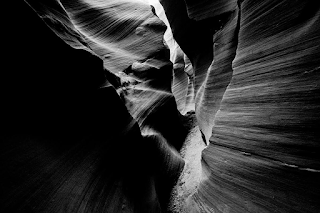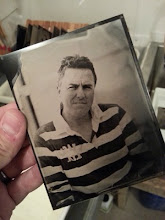Monday, February 26, 2018
Antelope Canyon Portfolio
These photographs are from a series I took back in 2007. They are photographs I kept going back to, but never feeling they were just right. In late 2017, ten years after my visit, I decided to revisit the photographs and take a different approach. After four months of processing work, the photographs are complete.
Both Antelope Canyons, Upper and Lower, have fascinated me as a photographic target for over 30 years. To me, they represent a challenge not just from the technical point of view with the huge range in brightness and tone, but also from the artistic standpoint. My struggle was in how I wanted to see the subject matter.
I have seen many photographs over the years that were in colour, and showed the canyon floors. While beautiful, the photos to me felt like someone documenting the canyons themselves. I wanted something different. While I wanted to photograph in the Canyons...I did not want the photographs to be of the canyons.
While I know that in itself sounds odd, I see the interior of the canyons more as abstract shapes... Light painting across a black canvas. This change in my interpretation of what I saw allowed me to approach the photographs in a different manner. Now, I see the results as light almost floating in a black void. These photographs now better portray how I felt while venturing through both canyons. While some may find them too dark, for me, they convey what I felt better than any previous attempts at viewing the work...and it only took me ten years to figure it out.
Saturday, November 2, 2013
Lexi. # 37
Sometimes I'm finishing off a roll....and I have that one extra shot. It's often the one that counts!
Minolta X700, 50mm f1.7 wide open, Kodak Ektar 100 at 80iso. B&W conversion in Silver Efex Pro 2
Minolta X700, 50mm f1.7 wide open, Kodak Ektar 100 at 80iso. B&W conversion in Silver Efex Pro 2
Monday, October 14, 2013
Emotional Narratives and the Low Fidelity Landscape
Final landscape shot from the day. Extreme front rise and front tilt.
"Words are the children of reason and, therefore, can't explain it. They really can't translate feeling because they're not part of it. That's why it bugs me when people try to analyze jazz as an intellectual theorem. It's not. It's feeling."
And so said Bill Evans, quoted during an interview from his Sunday at the Village Vanguard sessions. He rather eloquently attempted to state how difficult it was to describe a feeling. I find the same when people ask why I photograph a certain subject. For me, I find the object in the photograph is often not the subject of the photograph.
When I compose a subject in the viewfinder, I often am looking at describing an emotion, feeling, or sense of something. Recently, I have found myself moving away from the stale, sterile, and common place type of imagery I often see produced from digital cameras. There can be a repetitive, unemotional sense of fakery from them. It has became a rush to perfection that carried no emotion for me.
Many get caught up in online discussions with long diatribes on per pixel sharpness, shadow noise, creamy this or that at 300% screen magnifications....and have lost all sense of what really matters. They may as well spend their days photographing passports. This isn't a put down of digital capture per se, as I use digital gear a fair bit. That said, something more has caught my eyes as of late.
While I love using old film cameras, and I love the different look of film, a couple of years ago I started looking at some of the old, alternative processes. One in particular that seemed to carry on a story of its own was the Wet Plate Collodion process. How can a process carry its own story?
Fast forward to a couple of weeks ago. I joined a workshop put on by the Luz Studios. Quinton Gordon and Paul Romaniuk hosted a workshop teaching five of us a photographic process that dates back to the 1850's. Now I often process my photographs as best I can to try and describe the emotion or feeling I felt when I stood behind the camera. I tend to think of the final, completed image as an Emotional Narrative. That is how I feel about the imagery that can be produced using the old Wet Plate process.
Each image, because it is hand coated, is a one of a kind. Because the plates are hand coated and hand processed in the field, you never know what you are going to get. The final photographs convey more feeling and emotion than any other process I've used. These "Low Fidelity Landscapes" tend to be moody and dark....much like my personality sometimes!
After seeing the results, I'm hooked. Seeing my first plate appear in the developer was like watching my first silver gelatin print appear in my darkroom at age 13. These samples have all been scanned at 2400ppi on my Epson V700. Scanned straight from the glass, prior to varnishing the plate. The range of tones are incredible. I'll be featuring these, along with upcoming photographs, at my new site.
www.lowfidelitylandscape.com
And for those who really wish to take their photography and vision to another level, I highly recommend looking at some of the workshops held by the team at Luz Studios. Sign up for their darkroom to produce your own work. And Quinton, I think Turkish coffee should be mandatory for all photographic workshops!!!
Sometimes we need a push to prompt us to look beyond and step forward from what we have been doing to see a change in our work. I've stepped back and decided the Wet Plate Collodion process is the best way to describe my photographic emotional narrative. What's yours?
Marks from allowing the Collodiun to dry prior to developing
My first Collodion coating and processing
Slightly overexposed, but still tonally beautiful.
Sunday, September 29, 2013
A Little Film Magic
Sometimes the colour palette of film goes a long way to contributing to the final result. In this case, Kodak Ektar 100 rated at iso 64. Photographed with a 30 year old Minolta X700 and 50m f1.7, used wide open. Nothing like fullframe on the cheap. In this case, the camera and lens came to $50.
Gotta love the almost painterly colour to these! Film ain't dead yet!
Gotta love the almost painterly colour to these! Film ain't dead yet!
Monday, June 18, 2012
Subscribe to:
Comments (Atom)






























































